Photographs of a
disappearing city
The first twenty four of the following photographs were
taken in August and September 1961 by an anonymous photographer. They
are probably from a 24 shot, 120 roll film. They were found, carefully
captioned, in an album that originally turned up at a postcard fair in
Bristol. This is the first time they have been published with their
original captions, along with additional notes beneath the image if
required. The album had the following written in the front:
Sep 1962
Bits of the 'Older
Exeter'. Some of the photographs show 'derelict houses' waiting to be
demolished. Other photographs are of slum property still occupied.
I have also added some additional photographs from circa
1965, of other buildings in the Exe Island and Shilhay area, taken by
Alan H Mazonowicz. Together they show the housing of many Exonians from
Victorian times until the slum clearances and rebuilding of the 1960's.
Please note that all these photographs are © 2007 Exeter Memories.
|
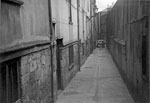 Rackclose Place Rackclose Place
Derelict, Sep 1962
Beedles Terrace on the right.
See Rack Street
& Rack Close Lane
|
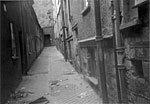 Rackclose Place Rackclose Place
Derelict, Sep 1962
Beedles Terrace on the left.
"I ... stayed with my
auntie and uncle at their house in Beedles Terrace every weekend during
the late 50's and early 60's. I remember the gas street
lights being lit at night. The houses on the left ..." Memories of Graham Sclater.
|
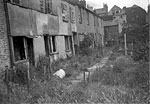 Beedles Terrace Beedles Terrace
(rear of Rackclose Place)
Derelict, Sep 1962
"... had small gardens
with a path that was used by other people, the toilets were at the
bottom of the garden and a communal wash house down the steps next to
it. They overlooked what used to be the slaughterhouse. The garden had a
wonderful view out across the city. They had no hot water, just one cold
water tap under the stairs and I remember my uncle shaving and then
pouring the water over the coal stored under the stairs."
Memories of Graham Sclater.
|
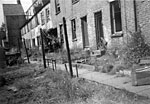 Beedles Terrace Beedles Terrace
(rear of Rackclose Place)
Derelict, Sep 1962
"I had a pot
under the bed. We had no heating only two coal fires on the ground
floor. I remember walking to the end of the terrace and up into
Bartholomew Street where my other aunties had a flower shop."
Memories of Graham Sclater.
|
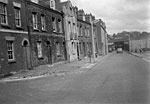 Old Houses Commercial Road Old Houses Commercial Road
Sep 1962
These houses were the first houses on the left as you entered
Commercial Road from its junction with Edmund Street. See Commercial Road
|
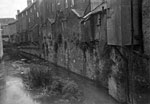 Rear of above houses/the leat Rear of above houses/the leat
Sep 1962
Refers to the photograph on the left. The photograph was taken from
Horsepool Bridge, almost opposite St Edmunds Church.
|
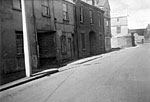 Old property Commercial Road Old property Commercial Road
Showing Victoria
Cottages (1869) and old shop
Derelict Sep 1962
These properties were on the same side of the road and close to the
warehouse clubs in Commercial Road. The opening by the wall in the
distance is shown in the next photo, and the building in sunlight is
Bodley Bros. & Co Ltd, brass and iron founders.
|
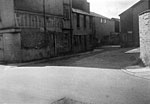 Old property Commercial Road Old property Commercial Road
Derelict Sep 1962
This is the side
entrance to the old ironworks of Bodley Brothers - Victoria Cottages
are to the left. |
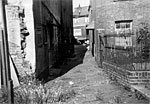 Tabernacle Place (from inside) Tabernacle Place (from inside)
Sep 1962
Tabernacle Place was a courtyard at the bottom of Coombe Street, close
to its junction with West Street. Chris Byles informs me that there was
a small chapel in the place, which will account for its name.
|
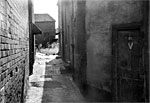 Tabernacle Place/from Coombe
Street Tabernacle Place/from Coombe
Street
Sep 1962
|
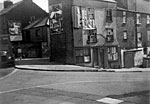 Old property/corner Coombe Street Old property/corner Coombe Street
Sep 1962
Coombe Street is on the left and Quay Hill on the right. Tabernacle Court was about
30 yards up Coombe Street, on the right. I have been informed that the
corner building was a second hand business up until 1953, when the
Council moved the family because the building had become unsafe. It was
also infested with rats from the leat and tannery below. The house was
lit with oil and gas lights as it had no electricity, it only had cold
running water and an outside toilet. The building remained empty and
wasn't demolished until after 1962. Information courtesy of Chris Byles.
|
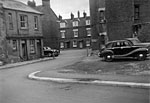 Looking into Mermaid Yard Looking into Mermaid Yard
Sep 1962
Cotton Building is
the block on the right. Cotton building had wash houses for the
residents and toilets situated at each end of the balconies. Both
Cotton and Folletts Building had 4 floors, 3 of which had balconies and
a flat roof which where used for washing lines. Follett's had interior
plumbing and toilets for the flats and two rubbish chutes in each
passage way; workmen had to shovel them out regularly. Follett's
Building overlooked Coombe Street out of the photo, on the left.
Information courtesy of Robert Stewart.
|
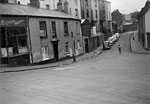 Old property (bottom of Paris
Street) Old property (bottom of Paris
Street)
Aug 1962
See Paris Street
|
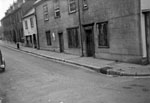 Derelict house/bottom of Paris
Street Derelict house/bottom of Paris
Street
Aug 1962
|
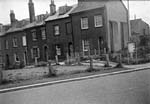 Houses in Russell Street, Newtown Houses in Russell Street, Newtown
Aug 1962
|
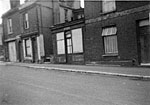 Old shops Belgrave Road Old shops Belgrave Road
Aug 1962
|
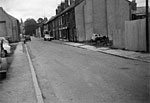 Parr Street, Newtown Parr Street, Newtown
Aug 1962
See Newtown
|
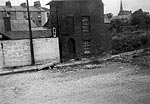 Old property Russell Street Old property Russell Street
Aug 1962
|
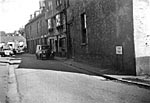 Very old property Tudor Street Very old property Tudor Street
Aug 1962
Some of the only buildings photographed that still exist - the centre
building is the well known Tudor
House and Eagle House, part of the Eagle Foundry the near
building.
|
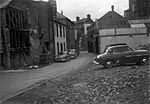 Frog Street/site of Tudor House Frog Street/site of Tudor House
Aug 1962
Taken from Edmund
Street, looking towards Exe Island. The caption is wrong - the small,
empty space on the left was the site of the Merchants House, moved in
1961, and now known as The
House that Moved. See Frog
Street |
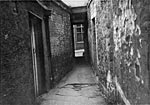 Kerrians Place, North Street Kerrians Place, North Street
Aug 1962
See North Street
|
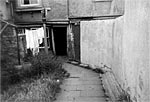 Chapel Court/rear entrance into
North Street Chapel Court/rear entrance into
North Street
Aug 1962
|
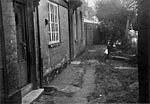 No caption No caption
Aug 1962
It is assumed that this is off Magdalen Street as it was paired with
the photo on the right.
|
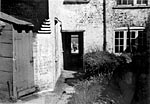 Inside Faulkner's Place, Magdalen
Street Inside Faulkner's Place, Magdalen
Street
Aug 1962
|
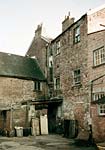 43 and 44 Alphington Street 43 and 44 Alphington Street
1965
|
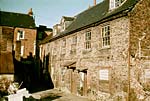 Browns Court, off Cowick Street Browns Court, off Cowick Street
1965
These dwellings were
behind Boots the Chemist on Cowick
Street, in an area now occupied by Boots and Next. |
 Tudor Street and the Tudor House Tudor Street and the Tudor House
1965
|
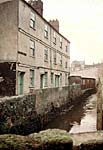 Leat Terrace, Cricklepit Leat Terrace, Cricklepit
1965
A story once
circulated in Commercial Road, that told of a builder who, during World
War Two, was engaged to construct new toilets at the back of Leat
Terrace. Holes were cut without any shoring - when they returned after
lunch, the whole building was leaning dangerously. The original toilets
emptied straight into the leat.
|
